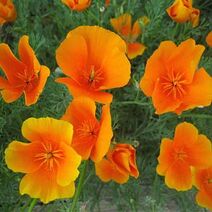Eschscholzia californica
| Eschscholzia californica | |
 | |
| Light: | |
| Moisture: | |
| Hardiness: | 6 |
| Soil pH: | 5.6-8.4 |
| Height: | 1' |
| Width: | 0.5' |
| Speed: | Fast |
| Blooms: | Mid Summer-Early Fall |
| Native to: | |
| Shelter Nectary | |
| Edible Rating: | |
| Medicinal Rating: | |
| Tea: | Yes |
Eschscholzia californica (common names: Californian poppy and California poppy)
Designated the state flower of California in 1903, this drought-tolerant poppy also has its own holiday on April 6th. The solitary, long-stemmed flowers have four satiny petals that range from creamy yellows to oranges and reds and sometimes pink, all with a dark orange center favored by many insects including oligolectic bees. The phototrophic flowers respond to sunlight and close at night or cloudy weather to reopen again when sunny. Long blooms can be extended with periodic deadheading and supplemental watering. A cold-weather annual or short-lived deep-rooted warm-weather perennial, the flowers self-seeds and is favored to help control erosion in Californian roadside plantings. The genus is named after the surgeon Doctor Johann Friedrich Eschscholtz by his close friend Adelbert von Chamisso, both of whom accompanied Otto von Kotzebue on his first expedition around the world in 1815-1818.
Propagation: Seed - sow in mid spring or late summer to early autumn in a sunny border outdoors and only just cover the seed[1]. Autumn sown plants may require protection from frosts in cold winters[1]. The seed usually germinates in 2 - 3 weeks.
Cultivation: Prefers a poor sandy soil and a sunny position[2][1] but is easily grown in an ordinary garden soil[3]. Succeeds in a hot dry position. Plants grow well in maritime climates[1].
A very ornamental plant, it is commonly grown in the flower garden and there are many named varieties[1]. This plant is the state flower of California[4]. Although a perennial it is usually quite short-lived and is more often grown as an annual in this country[5][6]. It can tolerate temperatures down to about -10°c, however, and often survives mild winters[5]. If the dead flowers are removed before they set seed the plant will continue flowering for a longer period[7].
A polymorphic species[8].
Plants resent root disturbance and should be sown in situ[1].
The flowers are very attractive to bees[2]. They close during wet or overcast weather[6].
Plants often self-sow if the soil is disturbed by some means such as hoeing[1].
Range: Western N. America. A frequent garden escape in Britain.
Habitat: Grassy open places to 2000 metres in California[8].
Edibility: Leaves - cooked[9][10][11]. This plant is in a family that contains many poisonous plants so some caution is advised in using it.
Medicinal: The Californian poppy is a bitter sedative herb that acts as a diuretic, relieves pain, relaxes spasms and promotes perspiration[6]. The whole plant is harvested when in flower and dried for use in tinctures and infusions[6]. It is taken internally in the treatment of nervous tension, anxiety, insomnia and incontinence (especially in children)[6].
The watery sap is mildly narcotic and has been used to relieve toothache[6]. It is similar in its effect to the opium poppy (Papaver somniferum) but is much milder in its action and does not depress the central nervous system[6]. Another report says that it has a markedly different effect upon the central nervous system, that it is not a narcotic but tends to normalize psychological function[12]. Its gently antispasmodic, sedative and analgesic actions make it a valuable herbal medicine for treating physical and psychological problems in children[12]. It may also prove beneficial in attempts to overcome bedwetting, difficulty in sleeping and nervous tension and anxiety[12].
An extract of the root is used as a wash on the breasts to suppress the flow of milk in lactating females[4][13].
Pollinators: Bees
Soil: Can grow in light, medium, and heavy soils.
Drainage: Prefers well drained soil.
Wind: Tolerates maritime wind exposure
Seed Ripens: Late Summer-Early Fall
Flower Type: Hermaphrodite
Known Hazards: No records of toxicity have been seen but this species belongs to a family that contains many poisonous plants. Some caution is therefore advised.
Also Known As: E. douglasii.
Seeds
Links
References
- ↑ 1.0 1.1 1.2 1.3 1.4 1.5 1.6 Huxley, Anthony. The New Royal Horticultural Society Dictionary of Gardening. MacMillan Press, 1992.
- ↑ 2.0 2.1 International Bee Research Association. Garden Plants Valuable to Bees. International Bee Research Association, 1981.
- ↑ Chittendon, Fred. RHS Dictionary of Plants. Oxford University Press, 1951.
- ↑ 4.0 4.1 Coffey, Timothy. The History and Folklore of North American Wild Flowers. Facts on File, 1993.
- ↑ 5.0 5.1 Phillips, Roger and Martyn Rix. Perennials - The Definitve Reference. Pan Books, 1991.
- ↑ 6.0 6.1 6.2 6.3 6.4 6.5 6.6 Bown, Deni. Royal Horticultural Society Encyclopaedia of Herbs and Their Uses. Dorling Kindersley, 1995.
- ↑ Brickell, Christopher. The RHS Gardener's Encyclopedia of Plants and Flowers. Dorling Kindersley Publishers, 1990.
- ↑ 8.0 8.1 Munz, David. A California Flora. University of California Press, 1959.
- ↑ Uphof, Johannes. Dictionary of Economic Plants. Weinheim, 1959.
- ↑ Usher, George. A Dictionary of Plants Used by Man. Constable, 1974.
- ↑ Yanovsky, Elias. Food Plants of the North American Indians Publication 237. US Department of Agriculture.
- ↑ 12.0 12.1 12.2 Chevallier, Andrew. The Encyclopedia of Medicinal Plants. Dorling Kindersley, 1996.
- ↑ Moerman, Daniel. Native American Ethnobotany. Timber Press, 1998.